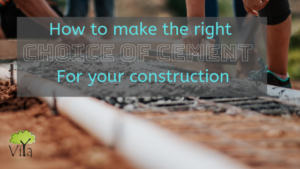Cement – one of the most important ingredients that binds together your dream home. This makes it extremely import that no mistakes are made in the choice of cement used in building construction. In this post, we look at a few things that a layperson should know, before they make their choice of cement.
What is cement?
Cement is basically a binding agent that acts as glue and adheres to building units like stones, bricks and tiles, thereby giving strength to the structure. It can also be used to seal any gaps or to make decorative elements in construction. Another use of cement is in waterproofing by mixing with water silicates and aluminates.
Cement is a very fine powdery substance made up of limestone (calcium), sand or clay (silicon), bauxite (aluminum) and iron ore. It may also include shells, chalk, marl, shale, clay, blast furnace slag, slate. These raw materials are processed in a cement factory to form a rock hard substance which is then powdered before use. When the powdered cement is mixed with water, it causes a chemical reaction. It then forms a paste that sets and hardens to bind individual structures.
The most important use of cement is in the manufacture of concrete and mortar. Concrete is made of cement, water, sand, and gravel mixed in definite proportions. Whereas the chief constituents of mortar are cement, water, and lime aggregate.
History
Before it reached its current form , cement has undergone several transformations. Early humans used clay as cement to seal the gaps in their huts. The Egyptians used a thin lime mortar in the erection of the pyramids. The Romans used the first hydraulic cement (cement that hardens when combined with water) in the middle ages. This was later replaced by the Portland cement.
Chemistry
There are two types of cement based on the way in which is it hardened.
Hydraulic cement: This type of cement hardens on the addition of water. It is made up of silicates and oxides. Hydraulic cement is most used for construction purposes in our country.
Non hydraulic cement: This is hardened by the process of carbonation with the carbon present in the air. Non hydraulic cement attains strength when it is kept dry. For this reason, non-hydraulic cement cannot be used underwater. Lime is an example of non hydraulic cement.
Portland cement
When the word cement used nowadays, it basically means Portland Cement. Portland cement is a hydraulic cement that forms a paste on addition of water and which eventually hardens to bind together stones, bricks, tiles etc.
There are different types or blends of Portland cement suited for specific purposes. They include Portland blast furnace slag cement, Portland fly-ash cement, Portland pozzolan cement, Portland-silica fume cement, masonry cement, expansive cement, white blended cement, colored cement and very finely ground cement.
How to use cement?
As we saw earlier in this article, cement is the major constituent of concrete. To express it in a simple form, concrete is a mixture of two components – aggregates and paste. The paste is formed by mixing water and cement and is used to coat the aggregates, which are basically small or coarse rocks. Through a process called hydration this paste hardens, and forms a rock like mass.
The secret behind achieving a strong and durable concrete lies in the mixing and proportioning of the ingredients. The quality of the concrete lies in the quality of the cement, which in turn depends on the ratio of water to cement. The water-cement ratio is the weight of the mixing water divided by the weight of the cement.
Pay close attention to the amount of water that you add. Too much water will result in weak concrete, whereas too little water will make the concrete unusable.
Similarly if the mixture does not have enough cement paste, it will produce rough surfaces and porous concrete. And excess of cement paste will result in concrete that will easily crack.
Additional Reading: What is RCC?
How to make the right choice of cement
If the quality of cement is not good, the quality and life of the building is at stake. So how do you tell the quality of cement used in your constructions?
You can very well follow a few simple techniques before making the choice of cement for your building construction.
Age
Strength of cement usually goes down with age. A year after the cement is manufactured, its strength drops by even 40-50%. In other words, use cement before the use by date, for best results; in most cases it is 90 days from the day of manufacture.
Colour
Good cement usually comes in grey colour with a slight tint of green. moreover it will always be uniform in colour.
Texture
When cement comes in contact with air, it absorbs the moisture. This results in the formation of and lumps. Good cement has no lumps.
Temperature
If you force your hands into a bag of good cement, your hands would feel cold. Bad cement feels warm to touch.
Consistency
Good quality cement floats in water for a while before sinking.
Hope this provides basic insight on the most vital ingredient in your house construction. For any further queries, or for a detailed discussion on construction, feel free to contact us.




Why to add a layer of PCC before foundation? Viya Constructions
[…] Additional Reading: How to choose the best type of Cement? […]
shwetha
can we use gypsum plaster for construction purpose
Andrew Cigna
Thanks for sharing this great information.